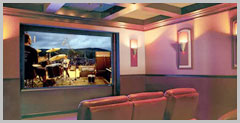





Audio Room Soundproofing
 Sound is absorbed by converting the vibrations of sound waves into heat energy. Fibrous materials such as insulation or foams make effective sound barriers because the strands absorb the vibration, creating heat in exchange. This is why area rugs on hardwood and tiled floors tame down the noise. Thick drapes can reduce sound volumes by up to 10 decibels when strategically placed. To put it in perspective, that would take you from a noisy restaurant to a quiet conversation at home. If you're the one making the racket in your living space, you can make your own soundproofing panels from Styrofoam and fabric as well. You can also install different shapes of foam or other porous material on walls to act as diffusers.
Sound is absorbed by converting the vibrations of sound waves into heat energy. Fibrous materials such as insulation or foams make effective sound barriers because the strands absorb the vibration, creating heat in exchange. This is why area rugs on hardwood and tiled floors tame down the noise. Thick drapes can reduce sound volumes by up to 10 decibels when strategically placed. To put it in perspective, that would take you from a noisy restaurant to a quiet conversation at home. If you're the one making the racket in your living space, you can make your own soundproofing panels from Styrofoam and fabric as well. You can also install different shapes of foam or other porous material on walls to act as diffusers.Bass Systems
 Bass traps control low frequency issues in rooms. Simply, they are the single most effective investment toward a quality audio experience that is rarely made. Bass traps are acoustic absorbers designed specifically to be effective down into the frequency range where room modes cause problems. Typical 3" thick fiberglass absorber panels start to lose effectiveness at around 250Hz whereas most of our modal resonance problems occur below 150Hz in the so called 'sparsely populated modal region'. Bass traps typically incorporate elements such as membranes, airspaces and additional thicknesses of fiberglass (up to 6" or more) to extend absorption down into the double digit range.
Bass traps control low frequency issues in rooms. Simply, they are the single most effective investment toward a quality audio experience that is rarely made. Bass traps are acoustic absorbers designed specifically to be effective down into the frequency range where room modes cause problems. Typical 3" thick fiberglass absorber panels start to lose effectiveness at around 250Hz whereas most of our modal resonance problems occur below 150Hz in the so called 'sparsely populated modal region'. Bass traps typically incorporate elements such as membranes, airspaces and additional thicknesses of fiberglass (up to 6" or more) to extend absorption down into the double digit range.
Acoustics
 In a movie theater, the room acoustics play a critical role in making sure that everyone can clearly hear the dialogue, no matter where they are seated. By eliminating near-wall reflections, those seated at the periphery are not fighting to discern the sound from the speakers versus the sound reflecting off the walls. The padded seats have been carefully designed to be comfortable, and when not in use, they help control bass. When a theater is properly treated, it improves our ability to comprehend what is being said. This is known as ‘intelligibility’.
In a movie theater, the room acoustics play a critical role in making sure that everyone can clearly hear the dialogue, no matter where they are seated. By eliminating near-wall reflections, those seated at the periphery are not fighting to discern the sound from the speakers versus the sound reflecting off the walls. The padded seats have been carefully designed to be comfortable, and when not in use, they help control bass. When a theater is properly treated, it improves our ability to comprehend what is being said. This is known as ‘intelligibility’.
Diffusion
 Diffusers help with sound transmission by altering the shape and surface of a wall to minimize and direct the amount of wave energy that bounces from one side of the room to the other. Just avoid concave shapes since it will draw the noise toward the wall. You can literally block sound out with mass. Large bookcases or bureaus against common walls could help insulate rooms. Concrete items in particular work well because their mass and porous quality absorbs some of the vibrations. When soundproofing in the home, one step that can greatly improve the situation is plugging up the crevices that sound burrows through. We're talking the cracks around baseboards, slits around window seals, you name it. Flexible caulking and weather stripping can seal the deal for these amplifiers. Door sweeps that block the area between the door and the floor allow for opening and automatically flip back down when it closes.
Diffusers help with sound transmission by altering the shape and surface of a wall to minimize and direct the amount of wave energy that bounces from one side of the room to the other. Just avoid concave shapes since it will draw the noise toward the wall. You can literally block sound out with mass. Large bookcases or bureaus against common walls could help insulate rooms. Concrete items in particular work well because their mass and porous quality absorbs some of the vibrations. When soundproofing in the home, one step that can greatly improve the situation is plugging up the crevices that sound burrows through. We're talking the cracks around baseboards, slits around window seals, you name it. Flexible caulking and weather stripping can seal the deal for these amplifiers. Door sweeps that block the area between the door and the floor allow for opening and automatically flip back down when it closes.
Copyright © 2013 www.hometheaterin.com